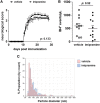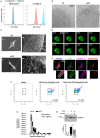Cytokines Stimulate the Release of Microvesicles from Myeloid Cells Independently from the P2X7 Receptor/Acid Sphingomyelinase Pathway
- PMID: 29467770
- PMCID: PMC5808348
- DOI: 10.3389/fimmu.2018.00204
Cytokines Stimulate the Release of Microvesicles from Myeloid Cells Independently from the P2X7 Receptor/Acid Sphingomyelinase Pathway
Abstract
Microvesicles (MVs) are membrane particles of 200-500 nm released by all cell types constitutively. MVs of myeloid origin are found increased in the cerebrospinal fluid (CSF) of patients suffering from neuroinflammatory disorders, although the factors triggering their production have never been defined. Here, we report that both pro- and anti-inflammatory cytokines, specifically interferon-γ and interleukin-4, are equally able to stimulate the production of MVs from microglia cells and monocytes. Additionally, we found this process to be independent from the best characterized molecular pathway so far described for membrane shedding, which is centered on the purinergic receptor P2X7, whose activation by high concentrations of extracellular ATP (exATP) results in membrane blebbing operated by the secreted enzyme acid sphingomyelinase (ASMase). Moreover, a potent inhibitor of ASMase, injected in a mouse model of multiple sclerosis, failed to reduce the number of MVs in their CSF. This suggests that cytokines, rather than exATP, may exert a long-term control of MV production in the context of chronic inflammation, where both pro- and anti-inflammatory factors play coordinated roles.
Keywords: P2X7; cytokines; inflammation; microvesicles; multiple sclerosis; myeloid cells; transcription.
Figures






Similar articles
-
IL-18 associates to microvesicles shed from human macrophages by a LPS/TLR-4 independent mechanism in response to P2X receptor stimulation.Eur J Immunol. 2012 Dec;42(12):3334-45. doi: 10.1002/eji.201142268. Epub 2012 Oct 26. Eur J Immunol. 2012. PMID: 22996386
-
Acid sphingomyelinase activity triggers microparticle release from glial cells.EMBO J. 2009 Apr 22;28(8):1043-54. doi: 10.1038/emboj.2009.45. Epub 2009 Mar 19. EMBO J. 2009. PMID: 19300439 Free PMC article.
-
Effect of fingolimod action on the release of monocyte-derived microvesicles in multiple sclerosis patients.J Neuroimmunol. 2018 Oct 15;323:43-48. doi: 10.1016/j.jneuroim.2018.07.008. Epub 2018 Jul 17. J Neuroimmunol. 2018. PMID: 30196832
-
The human P2X7 receptor and its role in innate immunity.Tissue Antigens. 2011 Nov;78(5):321-32. doi: 10.1111/j.1399-0039.2011.01780.x. Tissue Antigens. 2011. PMID: 21988719 Review.
-
New Insights into the Role of IL-1β in Experimental Autoimmune Encephalomyelitis and Multiple Sclerosis.J Immunol. 2017 Jun 15;198(12):4553-4560. doi: 10.4049/jimmunol.1700263. J Immunol. 2017. PMID: 28583987 Free PMC article. Review.
Cited by
-
NeuroEVs: Characterizing Extracellular Vesicles Generated in the Neural Domain.J Neurosci. 2019 Nov 20;39(47):9262-9268. doi: 10.1523/JNEUROSCI.0146-18.2019. J Neurosci. 2019. PMID: 31748281 Free PMC article. Review.
-
Role of sphingolipids in the biogenesis and biological activity of extracellular vesicles.J Lipid Res. 2018 Aug;59(8):1325-1340. doi: 10.1194/jlr.R083915. Epub 2018 May 31. J Lipid Res. 2018. PMID: 29853528 Free PMC article. Review.
-
Inhibiting extracellular vesicles formation and release: a review of EV inhibitors.J Extracell Vesicles. 2019 Dec 19;9(1):1703244. doi: 10.1080/20013078.2019.1703244. eCollection 2020. J Extracell Vesicles. 2019. PMID: 32002167 Free PMC article. Review.
-
Extracellular Vesicles in the Central Nervous System: A Novel Mechanism of Neuronal Cell Communication.Int J Mol Sci. 2024 Jan 28;25(3):1629. doi: 10.3390/ijms25031629. Int J Mol Sci. 2024. PMID: 38338906 Free PMC article. Review.
-
The Physio-Pathological Role of Group I Metabotropic Glutamate Receptors Expressed by Microglia in Health and Disease with a Focus on Amyotrophic Lateral Sclerosis.Int J Mol Sci. 2023 Mar 9;24(6):5240. doi: 10.3390/ijms24065240. Int J Mol Sci. 2023. PMID: 36982315 Free PMC article. Review.
References
Publication types
MeSH terms
Substances
LinkOut - more resources
Full Text Sources
Other Literature Sources
Medical

